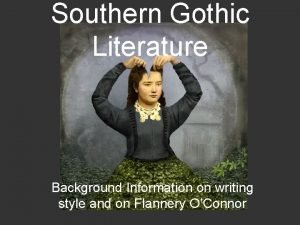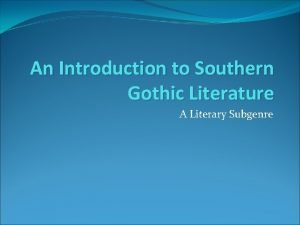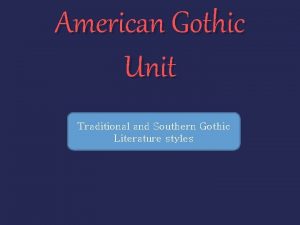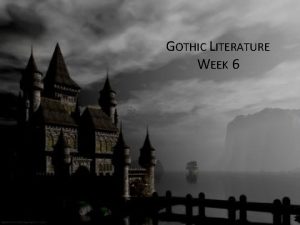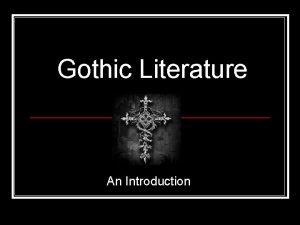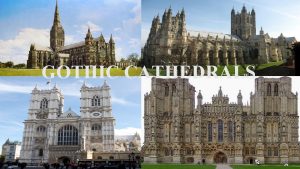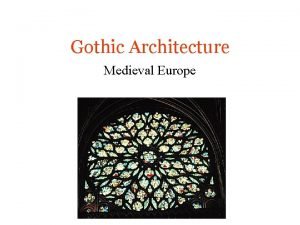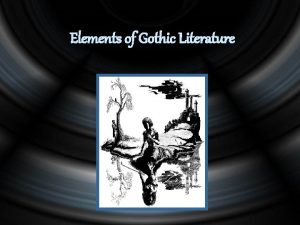A Gothic History Southern Gothic is a style






- Slides: 6

A Gothic History • Southern Gothic is a style of writing practiced by many writers of the American South whose stories set in that region are characterized by macabre or grotesque incidents. • Flannery O’Connor, Tennessee Williams, Truman Capote, William Faulkner, Anne Rice, and Harper Lee are among the best-known writers of Southern Gothic. • Southern Gothic is a mode or genre prevalent in literature

In Cold Blood derives in large part from Capote’s grounding in the Southern Gothic tradition of writing, an attribute only accentuated by Capote’s collaboration with Harper Lee during the research and writing of his novel, especially given the Southern Gothic characteristics so prominently on display in Lee’s own novel To Kill a Mockingbird. Capote’s treatment of Holcomb, Kansas, as a sleepy town thrust abruptly and irrevocably into the modern sense of malaise that accompanies such a grisly murder—here, a killing not just of the Clutter family but of a whole community’s (perhaps false) sense of security— cannot be separated from the Southern Gothic’s own frequent recourse to the sometimes-violent “crumbling and decay of antebellum culture” and its “lingering romantic nostalgia” (47). Voss, Ralph F. Truman Capote and the Legacy of In Cold Blood. Tuscaloosa, Alabama: University of Alabama Press, 2011.

Southern Gothic Literature • Southern Gothic is a subgenre of Gothic fiction. • Gothic fiction itself is an extension of Romanticism: both of these genres examined the concept of the individual. While Romanticism saw beauty, greatness, and hope when they looked at the individual, Gothic Literature saw the potential for evil and darkness. • Many characteristics we associate with horror movies come from the Gothic: • Spacious, yet claustrophobic, buildings that were at one point grand, but have fallen into disrepair • A sense of mystery and foreboding • Supernatural events • Grotesque imagery: unnatural or bizarre, or just simply odd and out of place • Questions of identity and dual personalities • Frayed nerves and a precarious mental state in the protagonist • Other horror tropes are present as well: howling dogs, strange noises in the night, thunder and lightning, ghostly presences

“A Rose for Emily” and In Cold Blood: A Study in Southern Gothic Literature In your groups, talk over the following questions: • What role does Emily play in the town of Jefferson? • What kind of relationship did she have with her father? • How does Emily avoid paying taxes? • What elements of foreshadowing does Faulkner develop throughout the short story? Find and discuss several examples. • How does the story end? What did you think of the shocking twist? • Discuss how this story might be viewed as a conflict between North and South. Keep in mind that Homer Barron is a (re)construction foreman and a northerner, while Emily Grierson comes from a genteel southern family. How might the physical descriptions of Miss Emily relate to this theme?


“A Rose for Emily” and In Cold Blood: A Study in Southern Gothic Literature • “We” in “A Rose for Emily” – The town, in many ways, is the narrator of both pieces. We see the gruesome nature of the crime through the eyes of the townspeople. • The worst in human nature comes out in both stories. • Both stories use grotesque and/or emotionally loaded imagery to create a foreboding tone. • Both stories have a focus on haunting physical locations. • Both contain elements of mystery that do not come to light until later. • Both groups of townspeople gossip about the “mystery” and what possibly happened. • Both authors utilize poetic language in the descriptions of both the towns and characters.
